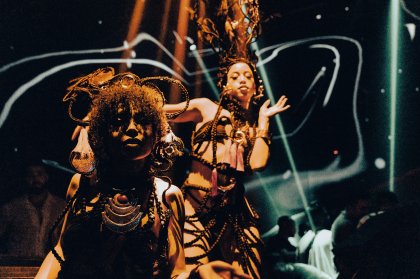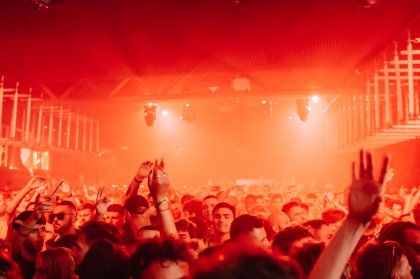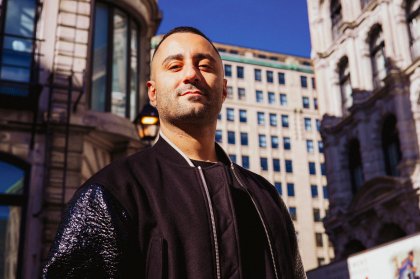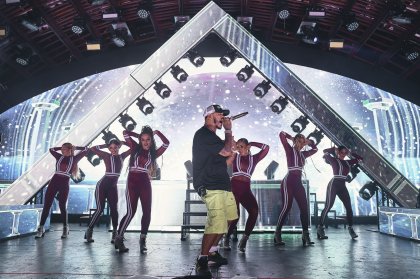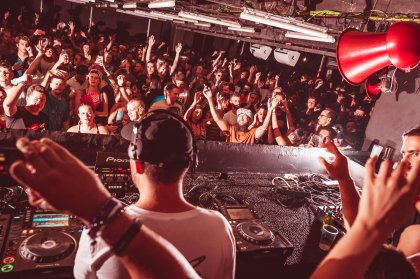
Biography
Stacey Pullen is the Kosmik Messenger. An innovator from the Second Wave of Detroit techno, he grew up under the mentorship of Detroit's legendary three: Derrick May, Juan Atkins and Kevin Saunderson. Still continuing to produce his characteristic atmosphere laden electronic sound, Stacey Pullen compounds his reputation as a producer with that of being one of the world's most in demand DJs, playing weekly across the globe year in, year out. With a font of passion for music and performance that never dries up, Stacey Pullen still plays every gig from the heart seeking to surprise and engage, to provide an unforgettable experience, to offer up his unique catalogue without predictability - defying expectation. Above all, from his earliest attempts to the current day Stacey Pullen has stayed true to his one goal: to become and to always be an Innovator.
From the age of 9, playing flute in his school band, Stacey has always been playing musical instruments. Throughout his school years, he developed a fantastic groundwork in analogue instruments and performance, moving from flute to his self-taught next choice of percussion. In his final years at school he found himself travelling around to a lot of cities in the USA playing in school bands, which gave him a taste of – and preparation for – the travelling involved in life as a musician. He had also seen and been prepared for a musician's life from watching his father who was in a Motown band called the Capitals in the 1970's, filling much of Stacey's childhood with observations of a life dedicated to music and travel.
Around 1985, while Stacey was still drumming and travelling with his high school band, the Detroit Techno movement was born, and provided a revolutionary sound to the youth of Detroit. The Electrifying Mojo filled the airwaves with this radicalism through new electronic rhythms, and showed a generation or more of musicians and DJs what true musical eclecticism means. Jeff Mills began to take musical technology to new levels redefining the borders between DJing and production in a way which had never been done before. DJs in Chicago like Farley Jackmaster Funk, Ralph Rosario and JM Silk were spinning proto-Chicago tunes on WBMX and Hotmix: they were the leaders of the new school of black music. The youth of Detroit, including Stacey, were listening and learning.
Stacey Pullen and some friends from his band took their cue from these musical leaders and began to experiment with turntables and a mixer. He would – as have many aspiring DJs since – spend his allowance on records and go hungry, going straight from school to the house of his friend who had equipment. He also started clubbing around the age of 15, the first club he frequented was called 'The Primadonna', the first DJ he remembered was a local legend called Alan Ester and the first music he was clubbing to was called 'Progressive Techno' – not in the sense of the word that we currently understand, but because, in Stacey's words “back then the music we called house music, techno, was also called progressive music – the meaning of 'progressive' was a futuristic way of thinking about music. That was what we called progressive. Back then for party music in Detroit only hip hop was big - music like techno was progressive then.”
His first DJing gig came in May 1985. It was also his first high school party and his first ever drink of beer. Stacey doesn't remember much about the music, but he certainly does remember the experience:
“It was that gig that let me know how tough it was to be a DJ. We set up the whole thing, brought the sound system, rented the hall, loaded in, loaded out and went home with 20 bucks a piece in our pocket. But it was more than money, to have that outlet - to have that power and make people respond to the music that we played.”
Stacey graduated and went to university in Tennessee, which was devoid of the progressive sounds of Detroit, and artists like MC Hammer reigned. He DJed at a few gigs, playing Model 500 and Rhythm is Rhythm and clearing the floor. He would make the eight-hour trip home at weekends to go to legendary Detroit club 'The Music Institute', and get his fix during the week with tapes he would share with fellow Chicago and Detroit students also left high and dry in Tennessee. In 1989, while still at university, Stacey bought his first drum machine – a Yamaha RX7, he thinks. Between the excitement he felt playing and the experiences he was having on the weekends, Stacey was left wanting more than he could fit into his university life. He decided to quit school and return home to Detroit and make a life of music. His parents, with his father's own musical history, supported Stacey's decision and he returned home, moved back in with his parents, and quickly started to develop his musical ambitions.
Almost living at the Music Institute, Stacey quickly got to know the leading lights of Detroit's underground: Alton Miller, Chez Damier, Derrick May. Alton was living in the same building as the club, and showed Stacey a lot of the background activity, including watching Derrick May making his tapes for his weekly radio show. Stacey approached Derrick, and told him that he made music - Derrick invited him to play some to him. From here, Stacey started hanging out at the Transmat studios and became friends with Jay Denham, who was recording on Transmat sub label Fragile as 'Fade to Black'. Jay was the main studio engineer for Transmat, and had full access while Derrick May was away. Stacey watched Jay work, and absorbed a lot of knowledge. Stacey started putting more sophisticated beats together, making his first real tracks. He played some to Derrick who told him “ it's cool but you need to work harder”. This pushed Stacey to become more thorough, to understand music better. He says:
“It was a good thing. It made me work harder, it made me realise that it's not just about making music. It's more than that: the passion you needed to have, the innovation we needed to have, what it is to be an artist.”
A couple of years later, in 1992, Derrick suggested that a good way to develop his skills would be for Stacey to do some remix work with Kevin Saunderson. Stacey began to work with Kevin on remixes including one for Karen White - 'The Way I Feel About You' and some which never made it to print, including one for the Prodigy. While Kevin was originally commissioned, he asked Stacey to do his own remix. The Prodigy liked it, but their label didn't. Stacey kept the backing track without the Prodigy samples, and turned it into his first track which was later released through a subsidiary of KMS in 1993.
After some more time perfecting his craft Stacey again played some original sounds to Derrick, who agreed to release his first Silent Phase track 'Wave the Rave Goodbye' as the 'Bango EP' on Fragile, which was Derrick's experimental label. Stacey was also invited to submit this track to a compilation of new Detroit artists on KMS. At this point Stacey truly became part of the Transmat/Metroplex/KMS team – the three studios worked very closely together, and were housed on different floors of the same building in downtown Detroit. Stacey now felt he had truly arrived as an artist:
“It made me feel really well, once we released Silent Phase I felt I was part of the crew. I had respect amongst my peers, so I didn’t care how much money it made. That record introduced Stacey Pullen to the world.”
This was true – quite literally – as in early 1993 Derrick, who was spending most of his time outside the USA at that time, started encouraging Stacey to play gigs in Europe to widen his audience and support the single. He invited Stacey to join him in Amsterdam for a month – that month became a year. He spent twelve months both as a teacher – educating Europeans as Electrifying Mojo had educated him about the electronic sounds of Detroit – and as a student – learning to DJ in a very small and competitive scene. He moved in with Derrick and together they toured Europe every weekend playing Detroit techno to what Stacey remembers as an enthusiastic and interested audience. Amongst the greats of US electronic artists he would play his own unreleased joints, and learned how audiences received his own creations as well.
It was an intense education into the world of DJing, and had its share of disasters including Stacey's very first European performance:
“My very first DJ show in Europe, I showed up with no records because my luggage got lost! I had to borrow other people’s records. It was a testing time for me but I learned a lot from it. It wasn't the best gig, but it was exciting more than anything. Imagine – my first gig ever - not showing up with my records! I had been DJing in the bedroom since 85 and this was 1993 but I think the guys that brought me over were so excited that I was there.
Being in Amsterdam, DJing was the thing that kept me going. Amsterdam was and still is a very competitive market for DJs. We were at record stores every day, buying records. As outsiders Derrick and me were very competitive, it was a good competitive spirit that made me develop my skills. I learned a lot, I learned how to play different styles. I was hearing a lot of music that wasn't coming to Detroit, I was going into different record stores and listening to different styles of music.”
Stacey began to play high profile gigs at clubs like London's Ministry of Sound and Paris's Rex Club and began meeting the DJs and artists that worked in Europe, like Laurent Garnier, Frank De Woolf and more. He talked with all who would listen about Detroit music. Paying attention was Renat and Marcus Salon from Belgian super label R & S, who invited Stacey into the studios to make a record, which ended up becoming the first Silent Phase album, 'Theory of Silent Phase' in 1994. Stacey met many techno artists through this time at R & S including CJ Bolland, The Advent's Cisco Ferreira, and Robert Leiner. But it was Marcus Salon who was most influential: during the making of Theory of Silent Phase he showed Stacey a lot of new technical knowledge at the vastly bigger and very well equipped R & S Studios. Coming from the makeshift Detroit studios, there was a lot to learn!
After a year, Stacey moved back to Detroit, ready to establish himself and start his own label. However, what he had started in that year in Amsterdam was a way of life which has never stopped to this day: almost every weekend since then Stacey has flown out of Detroit to a location somewhere in Europe – or elsewhere – to DJ for crowds wanting to taste a never dry appetite for new electronic and techno sounds. Throughout 1994 he commuted between Europe and the USA, finishing the Silent Phase album at R & S and DJing. He also made his first trips to Japan, South East Asia and Australia to DJ. By then he was busy enough to require an agent, and was being booked by Transmat's agent Laura. His association with Transmat was a red carpet to gigs all over the world. By then he had released another Fragile track 'The Sphinx' as Bango, and the first Silent Phase album was ready for release onTransmat in association with R & S. Not without its difficulties, mostly caused by recording on both sides of the planet and having to keep the sound consistent where possible between two analogue based studios, 'Theory of Silent Phase' was well received, although today he has regrets about the mastering, and Stacey played a lot of dates that year in support of the album.
Flooding in after the album release were a lot of offers for Stacey to record on other labels, including one from Mr C to record on his UK label Plink Plonk. Stacey had met Mr C a long time before when the Shamen invited him and Kevin Saunderson to remix The Shamen in another never-released project. This resulted in a couple of releases on Plink Plonk by the alias 'Kosmik Messenger' – 'Eye to Eye’ and 'Flash' - both released in 1995. He was also DJing a lot of dates at The End and around Europe, which continued non stop until 1997. Through his releases on Plink Plonk, Stacey was then invited to release on the new Belgian label 'Elypsia' as 'Kosmic Messenger', which led to the release of his second LP 'The Kollected Works of Kosmic Messenger', which Stacey recollects as a 'straight up techno album' for him, after the more spiritual first album on Transmat. He had 100% control over the album from the tracks to the artwork, which was produced by himself and his girlfriend at the time as a conceptual art project.
In 1998 Stacey was invited to produce his very first major label release on Virgin Records, and at the same time was planning to open the label he had wanted to start for about three years 'Black Flag'. He also recorded a more conceptual LP 'Today is the Tomorrow You Were Promised Yesterday ' for Virgin imprint ‘Science’, the first under his own name. He was very much influenced by his research into the history of Jazz, and – with the support of Virgin – used unorthodox ideas including the inclusion of an Opera Singer on one track 'Vertigo'. His release featured remixes from influential artists of the time like Dave Angel and 4 Hero. Stacey felt proud of the album, but its' release brought him a mixture of happiness and disappointment.
“This album gave me respect from avant garde purists, who love music other than techno. The only thing I was not happy with is that it never got a proper US release because it wasn't Aphex Twin or Chemical Brothers. At that time, this was an album that needed to be heard. It was inspired by jazz, roots and culture but wasn't nerdy music or breakbeat music. It was too fast forward, and not getting a proper release still bugs me to this day.”
Stacey Pullen was spending very little time in the US, despite his home in Detroit. He spent the next few years DJing, developing his taste and his ideas about himself, every so often coming home to his proudly self-built studio in downtown Detroit. He also started Black Flag with his partner of that time, and started releasing records as 'Black Odyssey', starting with 'Sweat' in 1998 and then 'The Stand in 2000'.
Around that time, as vinyl started to look a little shakier and after 8 years of consecutive releasing and touring, Stacey took a break from recording. Despite the number of offers he was receiving Stacey has always wanted to be conservative with his releasing schedule – keeping an audience attentive and wanting more rather than being over saturated. He preferred to aim for timeless music so Stacey felt that he would be better to have a break from recording rather than release anything less than classic. He began to ramp up his DJing schedule even more, and spent the next 4 to 5 years concentrating mainly on furthering his own musical education.
“I thought that maybe I needed to get back out in the DJ circuit and find out what was going on. I made it a point to go to places I've never been before and see people’s responses to what I played, and I’ve been doing that until now. It has been a good ride so far.”
Black Flag went on hiatus in 2001 and Stacey let the world of production – very much in flux in the early 21st century – take its course for a little while, while he concentrated on DJing. As one of the very few Detroit DJs travelling to Europe, he has still felt the need to provide some education about new underground electronic music – from Detroit and otherwise. Through this time, Stacey's reputation as a DJ became as much of a drawcard as his reputation as a producer, and he became renowned for long, experimental, adventurous and soulful journeys through music that lasted at least 5 hours. For Stacey 2 hour gigs are just a warm up! He sees each set as a 'best of' all dance music through time – there is no one style he prefers, Stacey just plays the best of everything, with an emphasis on passion and innovation: no two sets are alike.
2007 sees Stacey still on the road DJing each and every weekend, bringing his signature eclecticism to some lucky part of the planet, however many things have changed in the last 5 years in terms of a Stacey Pullen show. More opportunity to provide spontaneity and personalisation than ever exists, because of new technology, and Stacey is taking advantage of all of it! Many tracks he will play on any given night are edits he has created while travelling to a gig during that day! He DJs original tracks from vinyl, but many of his own edits and tracks are freshly burned to cd – edits of tracks he has made, he has been sent by other artists, promos, tracks he has bought. As a result, every set becomes more personalised, more unique, and indisputably a window into Stacey's musical passions.
The lure of this technological innovation has also brought Stacey back to the studio, making his own tracks and executive producing other artists. Also, excitingly, he has rekindled his Black Flag label and has been preparing new releases using a mixture of analogue equipment and digital post production which he thinks are amongst his best ever work, plus plans to release older material which has never been heard before. These days the DJing and the production go hand in hand in terms of his enjoyment and inspiration.
“I'd say I'm one coin with 2 sides. Heads and tails can't have one without the other. I have built my reputation more on being a good DJ, but the music I have put out and created has been well received. I have always strived for longevity, and I think right at this moment, my fans haven't heard the best of what I have to offer. I've also got loads of unreleased material that will be released, from 8 years ago and it sounds like it was made 2 weeks ago. It's going to be coming out on Black Flag in summer time here: June or July. Right now all I'm doing is sitting in the lab making the masterpiece. The future of music for me is exciting and will be an adventure, I'm excited about it and this is just the tip of the iceberg.”
Upcoming Dates
- 6th July, MusicON, Amnesia.
- 26th July, Vagabundos, Ushuaïa.
- 10th August, MusicON, Amnesia.
- 24th August, MusicON, Amnesia.
- 31st August, MusicON, Amnesia.
- 16th Sept, Vagabundos, Pacha.

